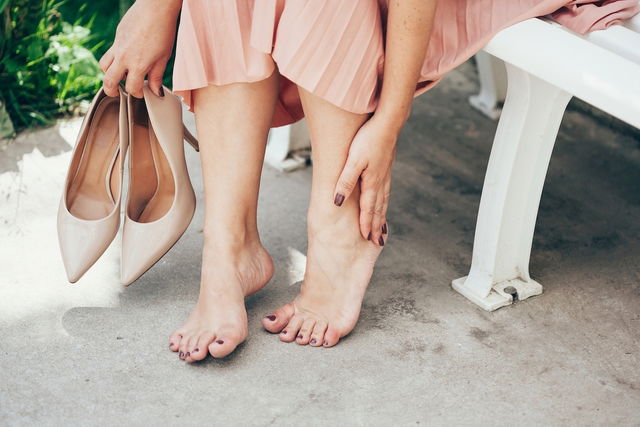Lateral foot pain is a symptom that can occur for many reasons, like muscular fatigue, bunions, tendinitis or sprains. It can affect the outer or inner side of the food and can occur with ill-fitting shoes, high impact exercises or repetitive movements.
In most cases, pain on the side of the foot lasts for up to 2 days and can be treated with ice compresses, rest and elevation of the affected foot.
If the pain doesn't improve, however, or if you experience pain with other symptoms like difficulty bearing weight, difficulty walking, or bruising, you should see a doctor for assessment and diagnosis. Depending on the cause, the doctor may initiate targeted treatment.

Causes of lateral foot pain
The most common causes of pain on the side of the foot are:
1. Muscular fatigue
Muscular fatigue is one of the most common causes of lateral foot pain. It can emerge after a fall, long walks on uneven terrain, exercising without a proper warmup, ill-fitting shoes or routine changes, like starting a new sport.
What to do: Elevating your foot can promote adequate circulation and relieve discomfort. You should also rest and apply cold compresses for 10 to 20 minutes, 3 to 4 times per day. Be sure to wrap any cold compresses in a cloth to avoid direct contact with the skin.
2. Abnormal gait
Some people have an abnormal gait that interferes with the way they walk and causes pain in the inner or outer side of the foot. With supination, the foot rolls onto the outer sides of the foot, putting more pressure on the pinky toe. With pronation, the foot steps off of the big toe and lands on the inner part of the foot.
Ideally, you should step off the ball of your foot to ensure weight and impact distributed evenly throughout the foot when walking.
What to do: If you suspect you have an abnormal gait, you should consult an orthopedic surgeon for assessment. Pain can be relieved with cold compresses, applied for 10 to 20 minutes, 3 to 4 times per day. Treatment may include the use of orthotics to promote a more neutral gait, as well as physiotherapy.
3. Bunions
Bunions, or hallux vagus, are a deformity in the bony joint of the big toe. They cause large, painful bumps below the big toe on the side of the foot, and can be caused by genetic factors or using tight shoes.
The formation of a bunion is usual gradual, and one of the initial symptoms is pain on the inner side of the foot.
What to do: Treatment is aimed at increasing the space between the big toe to the second toe, and this can be achieved with exercises, more comfortable footwear and orthotics. However, these interventions do not cure the bunion, but rather help to treat discomfort.
If you notice swelling in the area, you can apply cold compresses for 10 to 20 minutes, 3 to 4 times per day (being sure not to apply it directly to the skin). Very severe deformities may require surgical repair.
4. Tendinitis
In most cases, tendinitis in the foot is the result of repetitive movements or from high impact exercise, like jumping rope or running. Pain can be felt on the inner or outer side of the foot.
A tendinitis diagnosis is confirmed by the doctor through direct assessment and imaging, like ultrasound or MRI.
What to do: You should elevate the affected foot and apply cold compresses for 10 to 20 minutes, 3 to 4 times per day day. If pain and swelling persists even after an adequate rest period, the doctor may require more targeted treatment with medication and physiotherapy.
5. Sprain
A sprain is an ankle injury that can cause pain that radiates to the lateral foot. The sprain can be caused by a muscle strain or tear, and can occur after high impact exercise (like jumping rope or running) or accidents, like abrupt falls or direct trauma.
What to do: You should seek medical attention following a suspected sprain. The doctor will likely recommend elevation, cold compresses and immobilization. Anti-inflammatory or analgesic medication can also help to manage pain in the initial phases.
6. Cuboid syndrome
Cuboid syndrome is characterized by misalignment of the cuboid point in the foot. This can occur due to using ill-fitting shoes, repetitive movements or direct trauma, like a sprain. Cuboid syndrome can also emerge due to overloading on the bone from obesity.
Other symptoms of this condition include foot weakness, decreased sensitivity and overall discomfort with walking..
What to do: You should consult an orthopedic surgeon to confirm a diagnosis and initiate treatment that aims to reposition the cuboid bone. Anti-inflammatories and analgesics, as well as immobilization, may also be necessary.
When to see a doctor
You are advised to see an orthopedic surgeon if your lateral foot pain does not improve with time, or if it occurs with other symptoms such as:
- Difficulty weight-bearing or walking
- Bruising
- Intolerable pain that does not improve with medication
- Swelling
- Pus or discharge
The doctor will evaluate all symptoms and order additional testing, like an x-ray, to identify the cause of pain and to start treatment as necessary.
